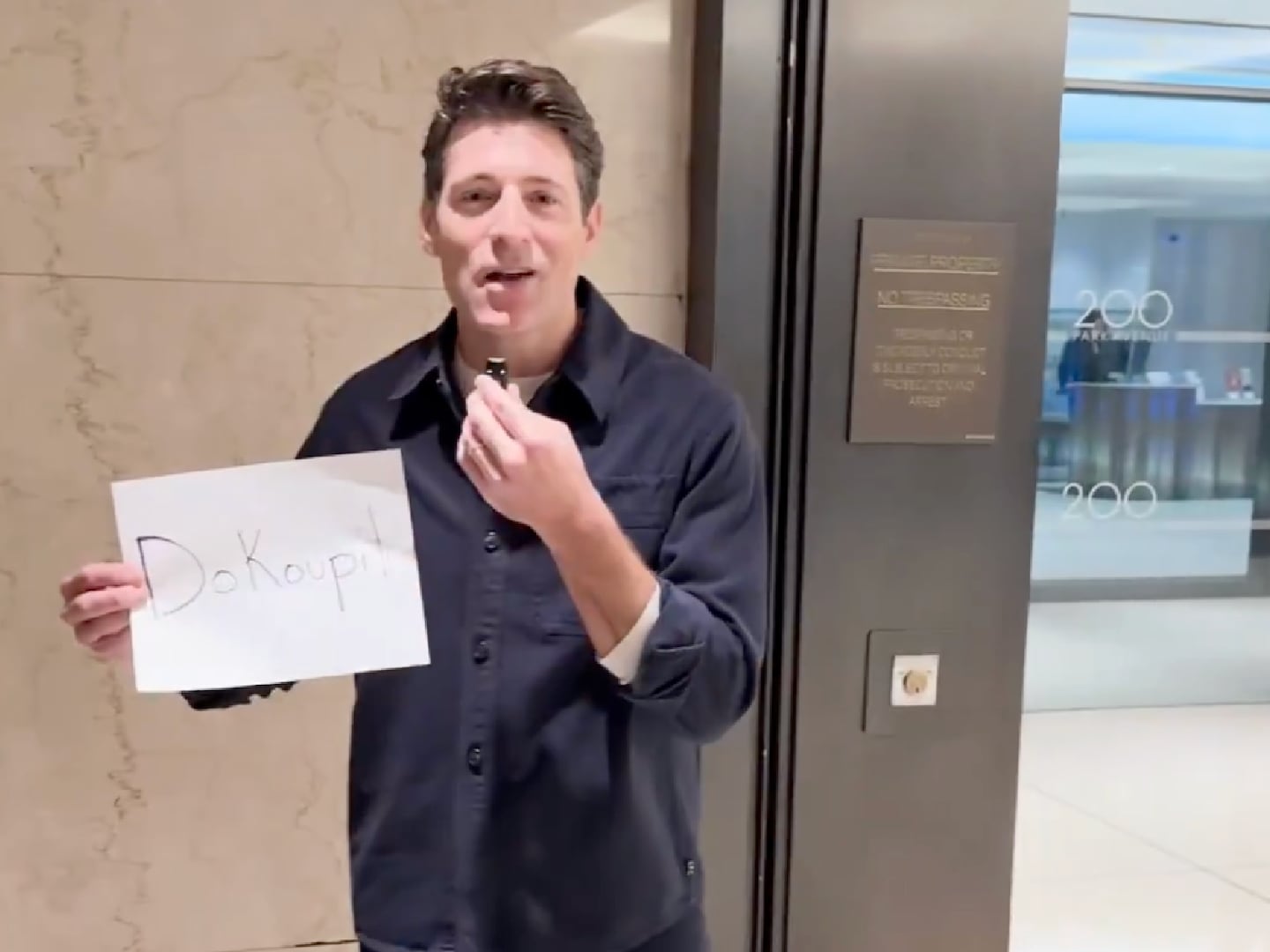It may be true that New York City’s gay bars are in sad decline. But Broadway’s Shubert Theatre on West 44th Street is one venue where, if you are prepared to part with a few hundred dollars, you can be around as many gay men (and many happy heterosexuals of course) as you could possibly wish. For it is here that Bette Midler, the Divine Miss M, has taken up residence in a revival of Jerry Herman’s equally divine musical Hello, Dolly!
Yes, this is a piece of Broadway theatre (with a book by Michael Stewart, it was first staged in 1964), but it is also a place of fierce devotional worship; the Shubert has been temporarily transformed into the rollicking Church of St. Bette.
Indeed, even if you are agnostic on Midler—really, what the hell are you doing there?—you will be captivated and delighted by this production, directed with exuberant vivacity by Jerry Zaks. Midler, taking on the role originated by Carol Channing, is marvelous, and so is the supporting cast which includes David Hyde Pierce as the gruff, befuddled, and ice-to-be-melted Yonkers storeowner Horace Vandergelder; and his initially-intended, Kate Baldwin’s dress shop-owner Irene Molloy, who instead will find unlikely love with Cornelius Hackl, one of Vandergelder’s shop-boys played by the all-leaping, dancing, and very funny Gavin Creel.
Despite all the diva-ishness and scene-hogging required of her, Midler is also a generous performer. Hyde Pierce is given ample space to huff and puff, and steal his own scenes. The only characters ill-served by Hello, Dolly! are young lovers Ambrose the artist and Ermengarde, Horace’s niece, who don’t get much to do, but appear resolute (him) and weep loudly (her) in their quest to be together.
The sheer joy of Hello, Dolly! starts immediately thanks to a fine orchestra, led by Andy Einhorn, who immediately make the atmosphere in the theatre thrum and shimmer. They are under the stage, and part of Warren Carlyle’s fabulous choreography is to manoeuver the actors around a perilous-looking, gaping hole that contains the musicians.
The story, should you need to know, is that it is 1890 and Dolly Gallagher Levi’s mind is focused on matchmaking Vandergelder with Mrs. Molloy. But, just as you may have seen with Barbra Streisand in the 1969 movie (which won four Oscars), Dolly’s mind is also on general meddling, fun and levity, and busying herself on the teeming streets of New York. Your business is her business. She can do anything for you, salubriously it should be emphasized, if the price is right.
Her smile suggests someone who has seen it all before. The fun and froth she bathes in is undercut throughout the musical with quiet and moving references to her beloved deceased husband Ephraim, which she addresses lovingly and directly to the heavens.
Whatever her machinations, it also seems entirely obvious that Dolly’s baiting of Horace for being such a fuddy-duddy is based on a secret love of her own—for him. Her matchmaking is a way to offset her own grief, and not face her own romantic travails. Baldwin’s gorgeously sung ‘Ribbons Down My Back’ is another lovely, quieter moment, as Mrs. Molloy stands in her hat shop contemplating romantic possibilities.
These muted moments don’t last long. Hello, Dolly! is really an exuberant and colorful burst of full-pelt singing and dancing, and Midler, as you would hope in this context, has an absolute ball. She dances gaily, she drawls languorously to irritate Horace, and her singing voice has transitioned from ‘Wind Beneath My Wings’ belter territory to something slightly softer but no less emphatic. When Midler leads the company in ‘Before The Parade Passes By’ to rousingly close out act one at a big-band procession on 14th Street, there is a commanding and sweet tenderness in her voice.
It would be easy for Midler to dial a knowingly camp performance in, but she does not, and she resists the temptation to mug to her adoring audience too much. But they cheer her anyway.
The biggest numbers in ‘Dolly!’ are ensemble, with the company in act one putting on their Sunday best and taking the train to New York. Santo Loquasto’s costumes are colored a rainbow of tangy sherbets, and replete with as many bustles and tassels as possible. His stage design—sensibly simple given the compactness of Shubert stage—is at its most elaborate for Vandergelder’s Hay and Feed Store, whose ladders, trapdoors, nooks, and crannies make for perfect slapstick accompaniments to song and dance numbers.
A similar principle informs the layout for the tables and closets in Mrs. Molloy’s dress-shop used to conceal Cornelius and Barnaby (Taylor Trensch), who emerge as the show’s most charming double act, as they begin their adventure in the big city, with Minnie Fay (Beanie Feldstein), Mrs. Molloy’s assistant, joining them and discovering she can dance along the way too.
Of course, you will be waiting to see how Dolly, the maître d’ Rudolph (Kevin Ligon), and his lithe team of waiters handle the title song-and-dance number at the Harmonia Gardens Restaurant, where Cornelius, Barnaby, Irene, and Minnie Fay are double-dating, and Horace is locked up in a gruesome date with Ernestina (a fantastically loopy Jennifer Simard), Dolly’s zonked-out pal, who’s going to not really love him but leave him as helpless a possible for Dolly’s taking.
Everything you want from the aperitif—‘The Waiters’ Gallop’—is there, with the male members of the company dancing and sliding and singing, while balancing precariously placed towers of plates, somehow managing to avoid crashing into one another.
And then Dolly, in her most fabulous red dress, with insane feathered crown, appears. The audience goes so insane you may think the roof will blow off, or the theatre itself will launch into outer space. As Dolly and the waiters perform 'Hello Dolly,' the men’s wonderful voices, singing in perfect unison in worship of her, remind you how stirring and glorious to listen to the best male voice choir can be. It is as immaculate, dream-like, and deliciously mad as the best kind of musical scene should be, with the added frisson of Midler’s affectionate, purred interjections, like “I’m stayin’ where I’m at, fellas.” That, of course, gets another roar.
Amazingly, Midler manages to ace the ecstasy of that number with a scene afterwards when, following the explosive fracas that engulfs the Harmonia, everybody but her lands up in court.
Dolly observes this unfold while still determinedly eating her supper. And boy, Midler knows how to make a meal out of eating a meal. Bones are chomped away at and gravy slurped for a magnificently extended sequence of time—until, all too quickly, the company is transported in all their sherbet-colored finery to the Hudson Valley, for a resounding happy ending.
Don’t be embarrassed if you find yourself laughing, giggling, smiling and whooping to the very last scene of Hello, Dolly! This is beautifully performed, and expertly directed song, dance, comedy, and farce. Midler may be the focus of the roars that accompany the curtain call, but her fellow actors, musicians and production staff deserve every bit of applause too.
To end, some free advice for those who’ve never been to a gay venue before. Approach the Shubert bar with care: it is a bad idea to get between a gay man who loves Bette Midler and who is also dead-set on a vodka tonic.
Hello, Dolly! is at the Shubert Theatre, 225 West 44th Street, New York City. Book tickets here.






